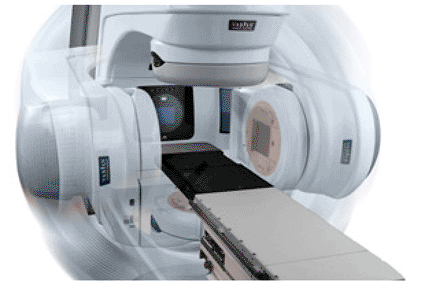Volumetric Arc Therapy Provides Faster, More Precise Cancer Treatments
By MedImaging staff writers
Posted on 30 Jan 2008
Posted on 30 Jan 2008

Image: The RapidArc technology and treatment machine for faster and more precise IMRT than with traditional imaging methods. (Photo courtesy of Varian Medical Systems).
RapidArc (RA), Varian Medical Systems' (Palo Alto, CA, USA) new technology for delivering volumetric modulated arc therapy, quickly provides a complete IMRT treatment in a single rotation of the treatment machine around the patient. Varian has received U.S. Food and Drug Administration (FDA) 510(k) clearances for its new RapidArc radiotherapy technology. The two FDA clearances for RapidArc cover the treatment hardware and the RapidArc treatment planning software module in Varian's Eclipse treatment planning system. Varian will begin taking orders for RapidArc immediately, and plans to begin delivering it to customers in the spring of 2008.
"RapidArc represents a major medical advance that will change the way radiation therapy is planned and delivered,” commented Dow Wilson, president of Varian's Oncology Systems business. "Our primary goal with this product is to improve clinical outcomes. In addition, we discovered that we could simultaneously improve treatment efficiency significantly.”
Plan studies comparing fixed-beam and helical IMRT with RapidArc show that RapidArc can reduce the amount of non-therapeutic radiation reaching healthy tissues during treatment. For example, in the case of head and neck cancer treatments, RapidArc plans are better at protecting critical structures such as the spinal cord, brain stem, eyes, optic nerve and chiasm, parotid (salivary) glands, and brain. Moreover, with Rapid Arc's highly efficient use of the primary beam, secondary stray radiation caused by scatter and leakage are reduced by over 50% on average compared with fixed field IMRT.
RapidArc technology utilizes a sophisticated, proprietary algorithm that creates a finely shaped IMRT dose distribution that closely matches the size and shape of the tumor. It works by varying three parameters simultaneously: 1) the speed with which the treatment machine rotates around the patient; 2) the dimensions of the beam-shaping aperture, which change continually during the treatment based on the patient's unique anatomy; and 3) the rate at which the dose is delivered. These technologies work together to make RA a revolutionary development in radiation therapy in terms of speed, efficiency, and conformality.
Related Links:
Varian Medical Systems














